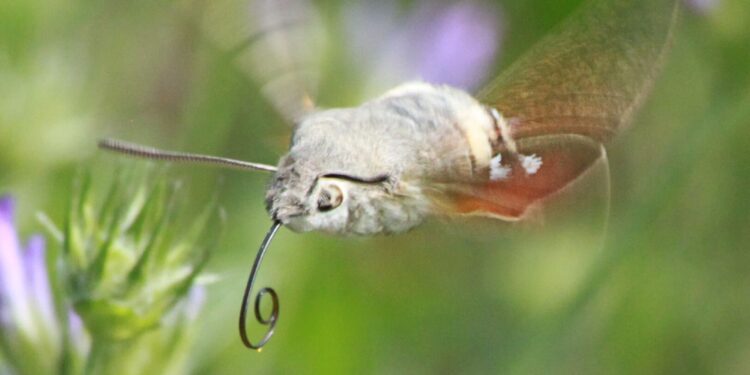Sphinx hummingbird (Macroglossum stellatarum) in search of food in France (Sorède) Credit: Anna Stöckl
Just like when we humans search for objects, the hummingbird hawkmoth uses its visual sense to place its long proboscis precisely on a flower in search of nectar, according to a study by biologists from Konstanz.
Have you ever seen a hummingbird hawkmoth? When people first encounter this butterfly, they are usually intrigued: resembling a cross between a butterfly and a bird (hence the name), this animal has the astonishing ability to hover like a helicopter for long periods of time .
On closer inspection, another feature of the hummingbird hawkmoth quickly catches the eye: the spirally coiled proboscis, which is as long as the entire animal.
The butterfly uses its proboscis to suck up nectar by inserting it through a small opening into the floral nectaries, seemingly effortlessly and within seconds. “It’s like trying to hit the opening of a drink can with a two-meter-long straw in your mouth,” explains Anna Stöckl, a biologist at the University of Konstanz.
In a study published in the journal PNASshe and her colleagues studied the sensory information that butterflies rely on to precisely control their proboscis.
They found that animals use their sense of sight to navigate and, if necessary, correct the movement of the proboscis using visual feedback on the path to the nectary, much like we humans do when we let’s grab something with our hands. This complex form of appendage control was previously known mainly in animals with relatively large brains, such as monkeys or birds.
Watching the trunk in slow motion
To demonstrate that this control of the appendages also occurs in insects, the researchers conducted sophisticated behavioral experiments in which hummingbird hawk moths were recorded with high-speed cameras as they approached artificial flowers.
In this way, they were able to determine the exact positions of the butterflies’ bodies, heads and proboscis with high temporal resolution while the animals were searching for nectar. Hummingbird hawk moths are known to use visible patterns on flowers, which they scan with their proboscis to gain quicker access to the sweet liquid.
Movement analysis initially revealed that hummingbird hawkmoths can only move their proboscis forward and backward about a centimeter and a half, and can barely move it sideways. To control the rough positioning of the proboscis within the flower, animals move their entire bodies in flight, while smaller movements of the proboscis itself are used to precisely target the flower pattern.
“It is very similar to our fingers, which, with the exception of the thumb, can primarily move forward and backward. However, we can perform very complex movements by also moving our hands for rough directional control , for example when we play the piano.” explains Stöckl.
Insect brains are masters of efficiency
There is another similarity with humans: Hummingbird hawkmoths need continuous visual information to move their proboscis precisely toward the nectary, just as we humans must keep our eyes on our fingers to direct them toward a target when we let’s perform untrained hand movements. If the butterflies’ eyes were covered so they couldn’t see their proboscis, they could still touch the flower. However, they no longer scan their proboscis along floral patterns, but randomly, which can prolong the search for nectar.
Single frame from high-speed video of the experiments. The positions of the animal’s proboscis on the flower are marked in color for a total duration of 30 seconds. Not visible due to black and white images: Featured a yellow cross pattern on a blue background. Credit: Stöckl Laboratory
The fact that butterflies use visual feedback for precise control of their proboscis was somewhat surprising, because such real-time coordination between what they see and the movement of their proboscis is computationally complex. Insects have a relatively simple nervous system with fewer than a million nerve cells, compared to nearly 90 billion in the human brain.
“To accomplish this task, insects have only a tiny fraction of the processing capacity of our human nervous system,” says Stöckl. This is exactly what makes them so interesting as a model organism for research into visual control of the appendages.
“And that’s not all. These small brains and their efficient functioning are also excellent models for applied research, for example in robotics. We can learn a lot from hummingbird butterflies,” emphasizes Stöckl.
More information:
Visual guidance refines the probing movements of an insect appendage, Proceedings of the National Academy of Sciences (2024). DOI: 10.1073/pnas.2306937121
Provided by the University of Konstanz
Quote: Scientists study the sensory information hummingbird butterflies rely on to control their proboscis (January 29, 2024) retrieved January 29, 2024 from
This document is subject to copyright. Apart from fair use for private study or research purposes, no part may be reproduced without written permission. The content is provided for information only.



